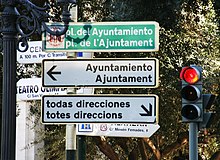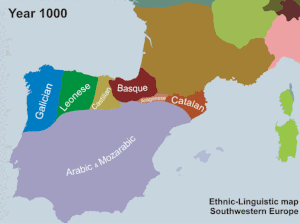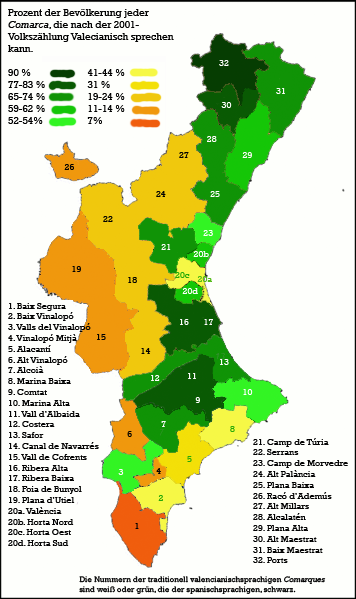Valencian
As a Valencian , also Valencian (proper name valencià; spanish valenciano ), the in the Autonomous Community of Valencia ( Spain officially recognized) and normalized variety of Catalan language called. Since 1982, Valencian has been the official language of the region alongside Spanish, in accordance with Article 7.2 of the Valencian Autonomy Statute . Mainly from language policy reasons, the position has been championed, Valencian whether as an independent, non-identical with the Catalan language to see what made linguistic not maintain visibility to the prevailing opinion, however.
distribution
Language area

Valencian, which is also officially introduced and standardized as a written language in the Valencian Community , is used in the coastal areas and in the plain of the Valencia region. The mountains in the interior and the extreme south of the region, on the other hand, are traditionally more or even exclusively Spanish-speaking. An adjacent area in the northwest of the province of Murcia , called Carxe , is partly Catalan-speaking (small linguistic islands with an Alicante dialect). Many Valencian place names are bilingual .
Sociolinguistics and Politics
While the majority of the inhabitants speak Spanish in the large cities of València and Alacant , in rural areas the Valencian is spoken with increasing self-confidence. For a long time, Valencian was considered a "peasant language" by the townspeople. Even during the dictatorship of Franquism , Valencian was spoken in the villages, although it was forbidden in the post-war period. Valencian is therefore associated with protest against Madrid and centralism . To this day, many old Valencians find it difficult to express themselves in the Spanish language. In the meantime, however, particularly young intellectuals from the region use Catalan or Valencian. Catalanists associate this with an idealization of life on the Mediterranean coast and, in the most extreme case, the political goal of a state that is detached from Spain, which could result from the political amalgamation of all Catalan-speaking areas (" Països Catalans "). Such ideas are, however, far less popular in Valencia than in the northern neighboring region of Catalonia , whose dominance in language and nationality issues in Valencia is often rated negatively and challenges the need for demarcation.
Education and culture
Since the beginning of the 1990s, teaching in schools has been offered bilingual and has since often shifted significantly to Valencian, i.e. main lessons, school books and exam papers are in Valencian, Castilian is only a subject. If you apply for a civil servant position in the Valencia region, you have advantages if you speak Valencian and, above all, write correctly. There are Valencian TV channels whose current programming is in Valencian. But even in such a television program it often happens that the guests of a talk show , for example, have mixed discussions in Valencian and Spanish. In Valencian television programs, unlike in Catalonia, there are no films with Catalan dubbing .
History and special features
After the area was wrested from the Moors by the Christian Reconquista in the 13th century, it was repopulated by Aragonese and Catalans. In the oldest texts from the 14th century, the Valencian idiom is referred to as catalanesc , and since the 15th century as valencià . The language of the Bible translation by Bonifacio Ferrer from 1478 is also called lengua latina en la nostra valenciana .
In rural areas, pronunciation and vocabulary differ from place to place; it is a dialect continuum with a smooth transition between the regions of Catalonia and Valencia. The Valencian dialects belong to the group of Western Catalan, which also includes the western regions of Catalonia , the Catalan-speaking part of Aragon and Andorra . In Valencian there are peculiarities in lexis , morphology and grammar . The orthography is taught as in the rest of the Catalan language area and goes back to the so-called norms of Castelló from 1932, which, while adapting to the Valencian language characteristics, adopts the norms that Pompeu Fabra established in Catalonia at the beginning of the 20th century.
For example, the use of the preposition ad , the broad semantic use of the preposition en ( en el meu amic "with my friends"), the neuter pronoun ho (from Latin hoc ) or the adverbial pronoun hi in conjunction with aver ( hi avia like in French: il y avait "there was"), the retention of the pronunciation of the r in the ending -er etc.

Some phonetic peculiarities of Valencian are also taken over into the written language, for example the possessives "my, your, his / her" are not written with v, as in standard Catalan, but with u - la meua, la teua, la seua instead of la meva, la teva, la seva . The first person singular is formed with -e instead of -o : jo cante, and there are different words, for example for “potato” and “girl”. The prosody total differs from Ostkatalanischen. Valencian can be understood by someone who knows Catalan, for example, from Barcelona , but has to listen, while a speaker from Lleida , for example , will have no problems, as the local variety also belongs to Western Catalan.
Controversial demarcation from Catalan
The status of Valencian - especially whether it should be viewed as a separate language or a variety of Catalan - has long been the subject of controversy.
The thesis that Valencian is an independent language compared to Catalan is mainly represented by conservative political forces oriented towards central Spanish nationalism. Its aim is to weaken Catalan nationalism in the Valencia region. The conservative Partido Popular , which ruled there from 1995 to 2015, strongly encouraged the independence of the Valencian language for this reason. For the independence thesis, however, mainly political reasons are put forward, which are often associated with anti-Catalanism. As a linguistic historical argument, it was cited that the language had its own name ( valenciano or valencià ) in the Kingdom of Valencia since the 15th century . A theory widespread among supporters of linguistic independence assumed that Valencian had developed from Mozarabic independently of Catalan . However, this idea was refuted by Germà Colon , which is recognized by the vast majority of Romance linguists, including at the University of Valencia. The Acadèmia Valenciana de la Llengua , guardian of the Valencian language according to Article 41 of the Valencian Statute of Autonomy, commented on the language issue on February 9, 2005 and stated that it was “in line with the most convincing contributions in Romance studies since the 19th century” Valencian language “from a philological point of view” identical to the native language of Catalonia , the Balearic Islands and Andorra . In this view, the different ways of speaking and writing in these areas together form a common language, regardless of the different names. This decision, which was already emerging in 2004, was controversial and also provoked protests from conservative politicians and Valencianistas . The academy also made it clear that valencià ("Valencian") is the appropriate name for the historical idiom used in the autonomy of Valencia , which belongs to the common language system recognized as a separate language in the Spanish countries of the former Crown Aragon becomes. This common language system is called "Catalan" in international usage.
Even after the publication of the Diccionari normatiu valencià in 2014, which took local and regional peculiarities and synonyms more into account than the previous editions , the dispute continued: while conservative Valencian politicians were excited about the equation of Valencian with Catalan, linguists criticized the dictionary I have included too many expressions of the popular vocabulary and local dialect terms without tying the selection to clear criteria, which endangers the unity of the Catalan language.
Since Valencian is not classified internationally as an independent language, it shares the ISO-639 language abbreviations caand catthe SIL code CLNwith Catalan.
Knowledge of the language
The following map shows the percentage of the population of each comarca who say they can speak Valencian:
Literati
- Jordi de Sant Jordi (approx. 1398 – approx. 1424)
- Ausiàs March (approx. 1397–1459)
- Joanot Martorell : Tirant lo Blanc (1490)
- Joan Roís de Corella (1433 / 43–1497)
- Jaume Roig (approx. 1400–1478): Espill o Llibre de les dones, y la escuela satírica valenciana
- Sor Isabel de Villena (1430-1490)
- Vicent Andrés i Estellés (1924–1993)
literature
- Hans-Ingo Radatz: “Catalan” or “Valencian”? On linguistic secessionism in the country of València. In: Journal of Catalan Studies . Volume 6, 1993, pp. 97-120 (online) .
- Manuel Sanchis Guarner : La llengua dels valencians. Eliseu Climent, València 1996, ISBN 84-7502-082-8 .
- Antje Voss: The Valencian between autonomy and assimilation. Linguistic and sociolinguistic studies on a Spanish Comunidad Autónoma. Peter Lang, Frankfurt am Main 2002, ISBN 3-631-38552-8 .
- Max Doppelbauer: How valencià became its own language. Critical analysis of the dictamen and Nou Estatut . In: Journal of Catalan Studies. Volume 21, 2008, pp. 281-296 ( online : PDF; 173 KB).
- Hanna Budig: Language as a symbol of identitarian divergence. Catalan in Valencia between the national language, standard language and dialect (= Bamberg Contributions to Linguistics. Volume 20). University of Bamberg Press, Bamberg 2019, ISBN 978-3-86309-660-1 , limited preview in the Google book search ( full text of the dissertation (PDF; 4.2 MB), University of Alicante, 2018).
Web links
- Real Acadèmia de Cultura Valenciana (Valencian)
- Acadèmia Valenciana de la Llengua (Valencian)
- Description of the Catalan language and the problems of Valencian , Catalan studies at the University of Frankfurt
Individual evidence
- ↑ Una isla valenciana en Murcia. In: ABC . December 26, 2011, accessed July 16, 2020 (Spanish).
- ↑ Pau Giner i Bayarri u. a .: El Valencià, una llengua des sail XXI . Online (Valencian, Spanish, English, German, with detailed bibliography) (PDF)
- ↑ No hi havia a València dos amants com nosaltres - “In Valencia there were no two lovers like us.” Vicent Andrés Estellés: Els amants on cancioneros.com.
- ^ Diari Oficial de la Generalitat Valenciana of May 6, 2005 (Catalan, Spanish) .
- ↑ La equiparación del valenciano al catalán por la Academia Valenciana de la Lengua exaspera a entidades valencianistas. In: elconfidencialdigital.com, February 14, 2004.
-
↑ Acord de l'Acadèmia Valenciana de la Llengua (AVL), adoptat en la reunió plenària del 9 de febrer del 2005, pel qual s'aprova el dictamen sobre els principis i criteris per a la defensa de la denominació i l'entitat del valencià :
- El valencià, idioma històric i propi de la Comunitat Valenciana, forma part del sistema lingüístic que els corresponents Estatuts d'Autonomia dels territoris hispànics de l'antiga Corona d'Aragó reconeixen com a llengua pròpia.
- ↑ Francesc Esteve: Dialectalitzant, incoherent, multiplicador de variants ... i sovint sense criteri ("Dialect- heavy , incoherent, accumulating variants ... and often without criteria") on: vilaweb.cat, February 7, 2014.



